Fact-Checking USPS Shipping Delays: What You Need to Know

Chances are, you’ve heard rumors of USPS shipping delays. Or perhaps, you’ve seen or experienced changes first-hand as a merchant or even as a consumer that relies on USPS for deliveries.
But, just how prevalent are the reported delays?
What should your business expect?
And, should you consider changing your shipping strategy?
At Shippo, we see time-in-transit and delay data from millions of shipments every week, across all distances and service levels from dozens of top carriers. In this post, we’ll compare USPS’s recent performance to both historical data and top private carriers to help you answer these questions and make the best decisions for your business and customers.
In addition, we’ve prepared a full analysis if you’d like to go deeper. Here, we’ve summarized those findings and added a few tips as well.
If you only have a couple of minutes to read and need the TL;DR:
Overall, the USPS remains a reliable choice for most e-commerce shipments. Since the beginning of July, we’ve seen small increases in transit times and delayed deliveries for longer shipments starting at Zone 5 and up. Shorter-distance shipments, on average, remain mostly unimpacted.
However, there are outliers, both in the form of individual merchants and specific routes that are experiencing delays far greater than the average from USPS. If your business is experiencing the impacts of these outliers, UPS and/or FedEx, both of which have not experienced any noticeable slowdowns of increases in delays, can offer greater reliability. That said, depending on your business’s resources, the costs of shifting volume to a new carrier could outweigh the benefits.
Before we go deeper, here are some notes to keep in mind:
- Shippo’s data is specific to package shipments and not letter mail.
- This analysis covers changes that have occurred since July as a result of changes in operations by the USPS. Though, it is worth noting that the USPS also saw a spike in transit times of around .5 days (slightly higher for longer-distance shipments and slightly lower for shorter-distance shipments) when comparing April, May, and June to February and early March prior to shelter-in-place orders. That said, the percentage of delayed shipments did not rise from over the same period since USPS started providing longer delivery estimates.
- Several of the trend graphs below cut off after the first week of August. This is because the more recent shipment data is skewed. Why? Because more recent days have shipments that are still in-transit, so if we were to look at transit times and delays, the data would be biased because we would only be analyzing the fastest delivered packages, and omitting those that are still in transit.
- The majority of our analysis focuses on USPS’s Priority Mail and First Class Package Service. This is because these are the most commonly used services and we have not seen any noticeable changes for Priority Mail Express.
USPS Delays: the Details
Here, we’ll dig into the data on changes in transit times and delays over time for USPS’s most popular services: Priority Mail and First Class Package Service.
Average transit times:
For short to medium distance shipments, up to Zone 4, we’ve seen small, but mostly insignificant increases in transit times starting back in July.
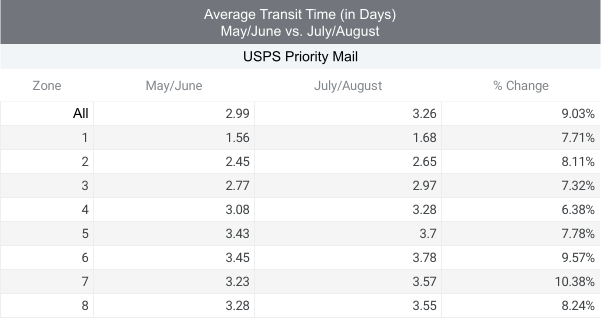

You’re probably wondering why average days in-transit fluctuates up and down within a week, in a uniform fashion overtime. Since the USPS does not deliver on Sunday, logically, a shipment initiated towards the end of a week, on Friday or Saturday, will likely be in transit for more days compared to one initiated on a Monday. You will also see spikes in late May and early July. The causes of these spikes were Memorial Day on May 25th and July 4th—both federally observed holidays. Shipments placed in the days leading up to these dates, on average, spent more days in transit since the USPS does not make deliveries on federally observed holidays.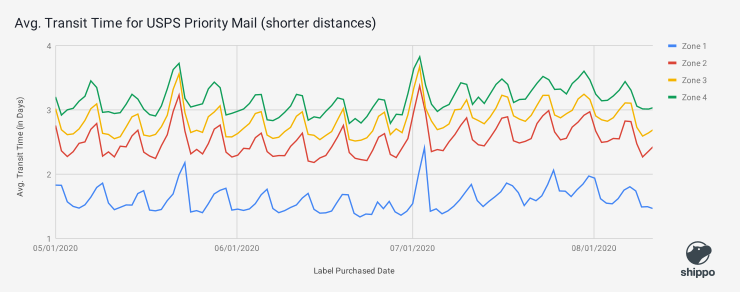

However, when we look at longer-distance shipments, Zone 5 through 8, we can see that transit times have increased towards the end of July and into August. That said, the average increases are around .5 days or less.
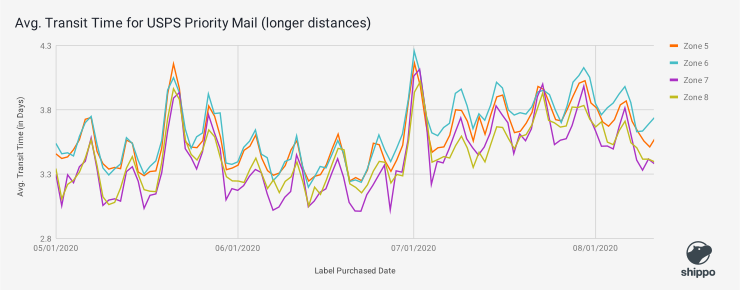

Prevalence of Delays:
The same trend holds true for the percentage of shipments with delays. We are seeing upticks across the board, with increasing prevalence in higher Zone shipments. In this instance, we are defining a delayed shipment as one that gets delivered after the originally planned ETA.


We see less change in shorter-distance shipments.
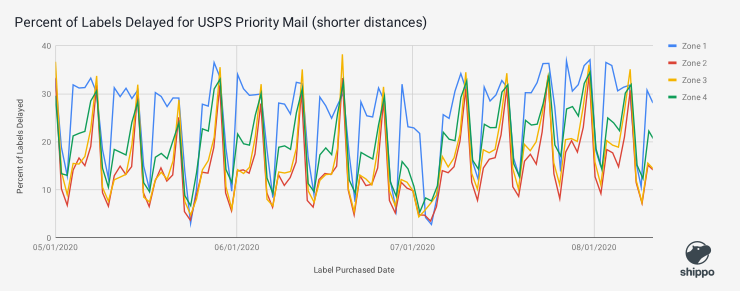
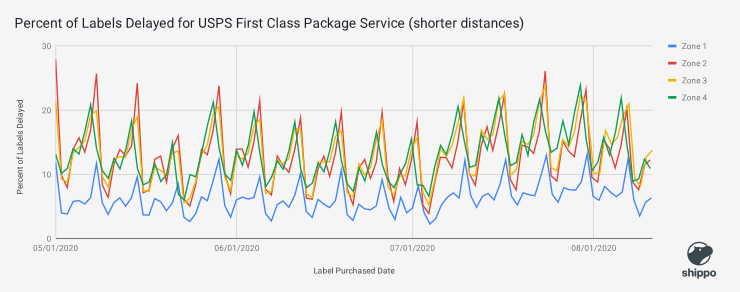
While for longer shipments, we’ve seen a noticeable uptick.
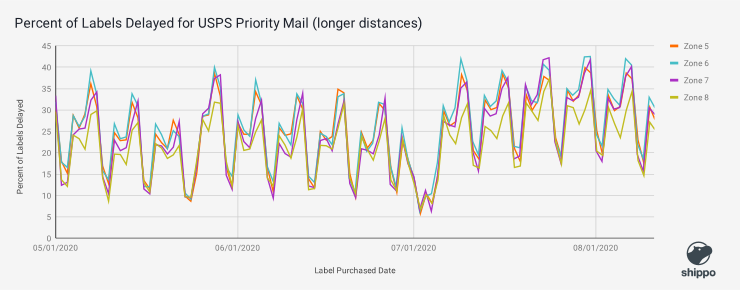

Which areas and routes are most impacted?
Looking at data from July and August, in total, 24% of Priority Mail and 17% of First Class shipments were delivered later than the originally scheduled delivery date. We also found several popular routes that are experiencing above-average delays. Here are the top ten for both Priority Mail and First Class.

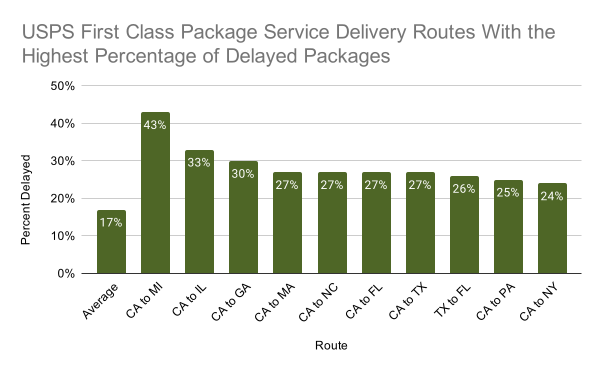
What is causing these delays?
In July, the USPS reportedly started reducing sorting times and limiting postal carrier overtime. These actions, in theory, result in less packages being sent out for delivery each day and fewer total trips taken by drivers. These limits, coupled with the continued record-high, e-commerce shipment volume amid COVID-19, are the likely causes of recent delays.
This week, the Postmaster General announced that the Postal Service would revert to their previous sorting protocols and allow overtime at least through November.
We will continue to monitor the situation and keep you informed on any rebound effects from these recent changes.
Should You Consider Shifting Your Volume to UPS or FedEx?
First, you’d probably want to know if UPS and FedEx are also experiencing increases in delayed shipments and longer transit times. The short answer is, no.
We have not seen any noticeable upticks in average transit times or delays. This includes both carriers’ respective overnight and air services, along with their ground services.
Now, should you shift volume? Unfortunately, there is no one-size-fits-all answer here.
Whether or not it makes sense for you to change operations will depend on circumstances specific to your business. The most obvious factor is whether or not you are currently experiencing delays that are hindering your customers’ experience.
If this is the case, you should then consider how equipped your business is to handle an operational change and if you are able to sustain higher shipping costs. If you already split your volume across multiple carriers—for example, USPS and UPS—then shifting a higher percentage of your shipments to UPS will likely not cause you to incur greater operational costs.
However, if you are currently using USPS for 100% of your volume, adding a second carrier will add some new operational costs. Specifically, you will now need to separate shipments into specific groups for each carrier at the end of your pick-and-pack workflow. Additionally, you will need to plan out how to get your shipments into your new carrier’s network. This will require scheduling a pickup with the carrier, which normally comes with a fee per pickup, or taking your packages to a designated collection location. In other words, you won’t be able to rely on other carriers coming to your address every day the way the USPS does.
In addition to operational costs, you will likely also incur increased shipping costs since UPS and FedEx tend to be more expensive than USPS for residential deliveries. That said, taking advantage of Shippo’s pre-negotiated discounts with UPS and FedEx can help to mitigate some of the increased costs you might see.
Another option to consider is USPS Priority Mail Express. The USPS’ fastest and most-reliable service comes with a premium price tag, but carries the benefit of not experiencing any significant delays. And, if you only have a small number of shipments that are in zones or routes that are extra susceptible to delays, splurging on the most-expensive USPS label on a limited number of shipments may be more cost-efficient than adding an entirely new carrier to your flow.
Anything Else?
Shipping is hard. Staying on top of the performance of multiple carriers each with various service levels can be daunting, even for the savviest merchants. That’s where Shippo comes in.
We’re committed to both providing your business with the technology you need to optimize your shipping across multiple carriers and keeping you informed with the latest changes.
Be sure to check out Shippo’s The Delivery Blog and subscribe to our newsletter for the latest insights and information. We’ll keep you up to date on how USPS and other top carriers are performing.













